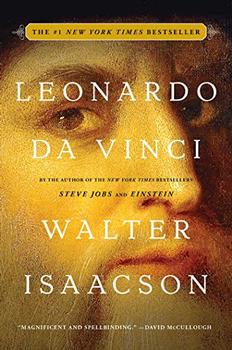Summary | Excerpt | Reviews | Beyond the Book | Readalikes | Genres & Themes | Author Bio

Critics' Opinion:
Readers' Opinion:
First Published:
Oct 2017, 624 pages
Paperback:
Oct 2018, 576 pages
 Book Reviewed by:
Book Reviewed by:
Rose Rankin
Buy This Book
CHAPTER 1: CHILDHOOD
Vinci, 1452–1464
DA VINCI
Leonardo da Vinci had the good luck to be born out of wedlock. Otherwise, he would have been expected to become a notary, like the firstborn legitimate sons in his family stretching back at least five generations.
His family roots can be traced to the early 1300s, when his great-great-great-grandfather, Michele, practiced as a notary in the Tuscan hill town of Vinci, about seventeen miles west of Florence. With the rise of Italy's mercantile economy, notaries played an important role drawing up commercial contracts, land sales, wills, and other legal documents in Latin, often garnishing them with historical references and literary flourishes.
Because Michele was a notary, he was entitled to the honorific "Ser" and thus became known as Ser Michele da Vinci. His son and grandson were even more successful notaries, the latter becoming a chancellor of Florence. The next in line, Antonio, was an anomaly. He used the honorific Ser and married the daughter of a notary, but he seems to have lacked the da Vinci ambition. He mostly spent his life living off the proceeds from family lands, tilled by sharecroppers, that produced a modest amount of wine, olive oil, and wheat.
Antonio's son Piero made up for the lassitude by ambitiously pursuing success in Pistola and Pisa, and then by about 1451, when he was twenty-five, establishing himself in Florence. A contract he notarized that year gave his work address as "at the Palazzo del Podestà," the magistrates' building (now the Bargello Museum) facing the Palazzo della Signoria, the seat of government. He became a notary for many of the city's monasteries and religious orders, the town's Jewish community, and on at least one occasion the Medici family.
On one of his visits back to Vinci, Piero had a relationship with an unmarried local peasant girl, and in the spring of 1452 they had a son. Exercising his little-used notarial handwriting, the boy's grandfather Antonio recorded the birth on the bottom of the last page of a notebook that had belonged to his own grandfather. "1452: There was born to me a grandson, the son of Ser Piero my son, on the 15th day of April, a Saturday, at the third hour of the night [about 10 p.m.]. He bears the name Leonardo."
Leonardo's mother was not considered worth mentioning in Antonio's birth notation nor in any other birth or baptism record. From a tax document five years later, we learn only her first name, Caterina. Her identity was long a mystery to modern scholars. She was thought to be in her mid-twenties, and some researchers speculated that she was an Arab slave, or perhaps a Chinese slave.
In fact, she was an orphaned and impoverished sixteen-year-old from the Vinci area named Caterina Lippi. Proving that there are still things to be rediscovered about Leonardo, the art historian Martin Kemp of Oxford and the archival researcher Giuseppe Pallanti of Florence produced evidence in 2017 documenting her background. Born in 1436 to a poor farmer, Caterina was orphaned when she was fourteen. She and her infant
brother moved in with their grandmother, who died a year later, in 1451. Left to fend for herself and her brother, Caterina had a relationship in July of that year with Piero da Vinci, then twenty-four, who was prominent and prosperous.
There was little likelihood they would marry. Although described by one earlier biographer as "of good blood,"5 Caterina was of a different social class, and Piero was probably already betrothed to his future wife, an appropriate match: a sixteen-year-old named Albiera who was the daughter of a prominent Florentine shoemaker. He and Albiera were wed within eight months of Leonardo's birth. The marriage, socially and professionally advantageous to both sides, had likely been arranged, and the dowry contracted, before Leonardo was born.
Excerpted from Leonardo da Vinci by Walter Isaacson. Copyright © 2017 by Walter Isaacson. Excerpted by permission of Simon & Schuster. All rights reserved. No part of this excerpt may be reproduced or reprinted without permission in writing from the publisher.





The House on Biscayne Bay
by Chanel Cleeton
As death stalks a gothic mansion in Miami, the lives of two women intertwine as the past and present collide.

The Flower Sisters
by Michelle Collins Anderson
From the new Fannie Flagg of the Ozarks, a richly-woven story of family, forgiveness, and reinvention.

The Funeral Cryer by Wenyan Lu
Debut novelist Wenyan Lu brings us this witty yet profound story about one woman's midlife reawakening in contemporary rural China.
Your guide toexceptional books
BookBrowse seeks out and recommends the best in contemporary fiction and nonfiction—books that not only engage and entertain but also deepen our understanding of ourselves and the world around us.